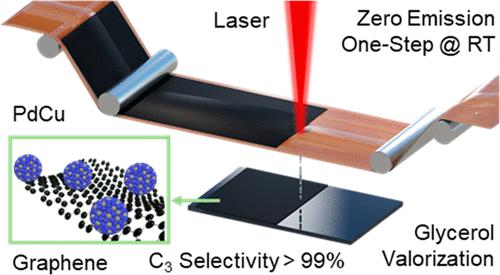Our official English website, www.x-mol.net, welcomes your
feedback! (Note: you will need to create a separate account there.)
Direct 3D Printing of Binder-Free Bimetallic Nanomaterials as Integrated Electrodes for Glycerol Oxidation with High Selectivity for Valuable C3 Products
ACS Nano ( IF 15.8 ) Pub Date : 2022-08-12 , DOI: 10.1021/acsnano.2c02865 Xiaoyong Mo, Xutao Gao, Armida V. Gillado, Hsuan-Yu Chen, Yong Chen, Zhengxiao Guo, Heng-Liang Wu, Edmund C. M. Tse
ACS Nano ( IF 15.8 ) Pub Date : 2022-08-12 , DOI: 10.1021/acsnano.2c02865 Xiaoyong Mo, Xutao Gao, Armida V. Gillado, Hsuan-Yu Chen, Yong Chen, Zhengxiao Guo, Heng-Liang Wu, Edmund C. M. Tse

|
Net-zero carbon strategies and green synthesis methodologies are key to realizing the United Nations’ sustainable development goals (SDGs) on a global scale. An electrocatalytic glycerol oxidation reaction (GOR) holds the promise of upcycling excess glycerol from biodiesel production directly into precious hydrocarbon commodities that are worth orders of magnitude more than the glycerol feedstock. Despite years of research on the GOR, the synthesis process of nanoscale electrocatalysts still involves (1) prohibitive heat input, (2) expensive vacuum chambers, and (3) emission of toxic liquid pollutants. In this paper, these knowledge gaps are closed via developing a laser-assisted nanomaterial preparation (LANP) process to fabricate bimetallic nanocatalysts (1) at room temperature, (2) under an ambient atmosphere, and (3) without liquid waste emission. Specifically, PdCu nanoparticles with adjustable Pd:Cu content supported on few-layer graphene can be prepared using this one-step LANP method with performance that can rival state-of-the-art GOR catalysts. Beyond exhibiting high GOR activity, the LANP-fabricated PdCu/C nanomaterials with an optimized Pd:Cu ratio further deliver an exclusive product selectivity of up to 99% for partially oxidized C3 products with value over 280000-folds that of glycerol. Through DFT calculations and in situ XAS experiments, the synergy between Pd and Cu is found to be responsible for the stability under GOR conditions and preference for C3 products of LANP PdCu. This dry LANP method is envisioned to afford sustainable production of multimetallic nanoparticles in a continuous fashion as efficient electrocatalysts for other redox reactions with intricate proton-coupled electron transfer steps that are central to the widespread deployment of renewable energy schemes and carbon-neutral technologies.
中文翻译:

直接 3D 打印无粘合剂双金属纳米材料作为甘油氧化的集成电极,对有价值的 C3 产品具有高选择性
净零碳战略和绿色合成方法是在全球范围内实现联合国可持续发展目标 (SDG) 的关键。电催化甘油氧化反应 (GOR) 有望将生物柴油生产中的多余甘油直接升级为珍贵的碳氢化合物商品,其价值比甘油原料高出几个数量级。尽管对 GOR 进行了多年研究,但纳米级电催化剂的合成过程仍然涉及 (1) 过高的热输入,(2) 昂贵的真空室,以及 (3) 有毒液体污染物的排放。在本文中,这些知识差距通过开发激光辅助纳米材料制备 (LANP) 工艺来制造双金属纳米催化剂(1)在室温下,(2)在环境大气下,(3)无废液排放。具体而言,可以使用这种单步 LANP 方法制备负载在少层石墨烯上的 Pd:Cu 含量可调的 PdCu 纳米颗粒,其性能可与最先进的 GOR 催化剂相媲美。除了表现出高 GOR 活性外,LANP 制造的 PdCu/C 纳米材料具有优化的 Pd:Cu 比例,进一步为部分氧化的 C 提供高达 99% 的独家产品选择性3个产品价值超过甘油28万倍。通过 DFT 计算和原位XAS 实验,发现 Pd 和 Cu 之间的协同作用是导致 GOR 条件下的稳定性和对LANP PdCu的 C 3产物的偏好的原因。这种干法 LANP 方法被设想为以连续的方式提供多金属纳米粒子的可持续生产,作为其他氧化还原反应的有效电催化剂,具有复杂的质子耦合电子转移步骤,这些步骤对于可再生能源计划和碳中和技术的广泛部署至关重要。
更新日期:2022-08-12
中文翻译:

直接 3D 打印无粘合剂双金属纳米材料作为甘油氧化的集成电极,对有价值的 C3 产品具有高选择性
净零碳战略和绿色合成方法是在全球范围内实现联合国可持续发展目标 (SDG) 的关键。电催化甘油氧化反应 (GOR) 有望将生物柴油生产中的多余甘油直接升级为珍贵的碳氢化合物商品,其价值比甘油原料高出几个数量级。尽管对 GOR 进行了多年研究,但纳米级电催化剂的合成过程仍然涉及 (1) 过高的热输入,(2) 昂贵的真空室,以及 (3) 有毒液体污染物的排放。在本文中,这些知识差距通过开发激光辅助纳米材料制备 (LANP) 工艺来制造双金属纳米催化剂(1)在室温下,(2)在环境大气下,(3)无废液排放。具体而言,可以使用这种单步 LANP 方法制备负载在少层石墨烯上的 Pd:Cu 含量可调的 PdCu 纳米颗粒,其性能可与最先进的 GOR 催化剂相媲美。除了表现出高 GOR 活性外,LANP 制造的 PdCu/C 纳米材料具有优化的 Pd:Cu 比例,进一步为部分氧化的 C 提供高达 99% 的独家产品选择性3个产品价值超过甘油28万倍。通过 DFT 计算和原位XAS 实验,发现 Pd 和 Cu 之间的协同作用是导致 GOR 条件下的稳定性和对LANP PdCu的 C 3产物的偏好的原因。这种干法 LANP 方法被设想为以连续的方式提供多金属纳米粒子的可持续生产,作为其他氧化还原反应的有效电催化剂,具有复杂的质子耦合电子转移步骤,这些步骤对于可再生能源计划和碳中和技术的广泛部署至关重要。











































 京公网安备 11010802027423号
京公网安备 11010802027423号